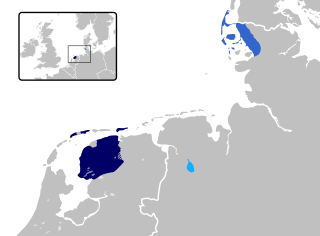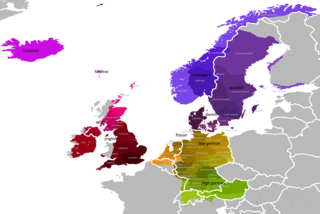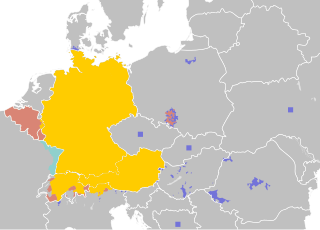
The Frisian languages are a closely related group of West Germanic languages, spoken by about 500,000 Frisian people, who live on the southern fringes of the North Sea in the Netherlands and Germany. The Frisian languages are the closest living language group to the Anglic languages; the two groups make up the Anglo-Frisian languages group and together with the Low German dialects these form the North Sea Germanic languages. However, modern English and Frisian are not mutually intelligible, nor are Frisian languages intelligible among themselves, owing to independent linguistic innovations and foreign influences.

The Germanic languages are a branch of the Indo-European language family spoken natively by a population of about 515 million people mainly in Europe, North America, Oceania and Southern Africa. The most widely spoken Germanic language, English, is also the world's most widely spoken language with an estimated 2 billion speakers. All Germanic languages are derived from Proto-Germanic, spoken in Iron Age Scandinavia.

German is a West Germanic language mainly spoken in Western Europe and Central Europe. It is the most widely spoken and official or co-official language in Germany, Austria, Switzerland, Liechtenstein, and the Italian province of South Tyrol. It is also an official language of Luxembourg and Belgium, as well as a recognized national language in Namibia. Outside Germany, it is also spoken by German communities in France (Alsace), Czech Republic, Poland, Slovakia, and Hungary (Sopron).

Low Saxon, also known as West Low German are a group of Low German dialects spoken in parts of the Netherlands, northwestern Germany and southern Denmark. It is one of two dialect groups, the other being East Low German.

In historical and comparative linguistics, Low Franconian, Low Frankish or Netherlandic is a linguistic category used to classify a number of historical and contemporary West Germanic varieties closely related to, and including, the Dutch language. Most dialects and languages included within this category are spoken in the Netherlands, northern Belgium (Flanders), in the Nord department of France, in western Germany, as well as in Suriname, South Africa and Namibia.
Northern Low Saxon is a subgroup of Low Saxon dialects of Low German. As such, it covers a great part of the West Low German-speaking areas of northern Germany, with the exception of the border regions where South Low Saxon is spoken, and Gronings dialect in the Netherlands.

Pennsylvania Dutch, sometimes referred to as Pennsylvania German, is a variety of Palatine German, also known as Palatinate German or Palatine Dutch, spoken by the Pennsylvania Dutch, including the Old Order Amish, Old Order Mennonites, Fancy Dutch, and other descendants of German immigrants in the United States and Canada. There are approximately 300,000 native speakers of Pennsylvania Dutch in the United States and Canada.
Plautdietsch or Mennonite Low German is a Low Prussian dialect of East Low German with Dutch influence that developed in the 16th and 17th centuries in the Vistula delta area of Royal Prussia. The word Plautdietsch translates to "flat German". In other Low German dialects, the word for Low German is usually realised as Plattdütsch/Plattdüütsch[ˈplatdyːtʃ] or Plattdüütsk[ˈplatdyːtsk], but the spelling Plautdietsch is used to refer specifically to the Vistula variant of the language.
East Frisian Low German or East Frisian Low Saxon is one of the Northern Low Saxon dialects, a West Low German dialect spoken in the East Frisian peninsula of northwestern Lower Saxony. It is used quite frequently in everyday speech there. About half of the East Frisian population in the coastal region uses the language. A number of individuals, despite not being active speakers of Low Saxon, are able to understand it to some extent. However, both active and passive language skills are in a state of decrease.

Low German or Low Saxon is a West Germanic language spoken mainly in Northern Germany and the northeastern part of the Netherlands. The dialect of Plautdietsch is also spoken in the Russian Mennonite diaspora worldwide.

The Dutch are an ethnic group native to the Netherlands. They share a common ancestry and culture and speak the Dutch language. Dutch people and their descendants are found in migrant communities worldwide, notably in Aruba, Suriname, Guyana, Curaçao, Argentina, Brazil, Canada, Australia, South Africa, New Zealand and the United States. The Low Countries were situated around the border of France and the Holy Roman Empire, forming a part of their respective peripheries and the various territories of which they consisted had become virtually autonomous by the 13th century. Under the Habsburgs, the Netherlands were organised into a single administrative unit, and in the 16th and 17th centuries the Northern Netherlands gained independence from Spain as the Dutch Republic. The high degree of urbanisation characteristic of Dutch society was attained at a relatively early date. During the Republic the first series of large-scale Dutch migrations outside of Europe took place.
Høgnorsk is a term for varieties of the Norwegian language from Nynorsk that reject most of the official reforms that have been introduced since the creation of Landsmål. Høgnorsk typically accepts the initial reforms that, among other things, removed certain silent letters of etymological origin, while keeping most of the Landsmål grammar intact.

German dialects are the various traditional local varieties of the German language. Though varied by region, those of the southern half of Germany beneath the Benrath line are dominated by the geographical spread of the High German consonant shift, and the dialect continuum that connects German to the neighboring varieties of Low Franconian (Dutch) and Frisian.
Dutch is a West Germanic language, that originated from the Old Frankish dialects.

Franconian or Frankish is a collective term traditionally used by linguists to refer to many West Germanic languages, some of which are spoken in what formed the historical core area of Francia during the Early Middle Ages. Linguistically, there are no typological features that are typical for all the various dialects conventionally grouped as Franconian. As such, it forms a residual category within the larger historical West Germanic dialect continuum rather than a homogeneous group of closely related dialects. For most of the varieties grouped under the term "Franconian", the diachronical connection to the Frankish language, which was spoken by the Franks, is unclear.

The languages of Bolivia include Spanish; several dozen indigenous languages, most prominently Aymara, Quechua, Chiquitano, and Guaraní; Bolivian Sign Language ; and languages of immigrants such as Plautdietsch. Indigenous languages and Spanish are official languages of the state according to the 2009 Constitution. The constitution says that all indigenous languages are official, listing 36 specific languages, of which some are extinct. Spanish and Quechua are spoken primarily in the Andes region, Aymara is mainly spoken in the Altiplano around Lake Titicaca, Chiquitano is spoken in the central part of Santa Cruz, and Guaraní is spoken in the southeast on the border with Paraguay.

Dutch, also known as Netherlandic or Netherlandish, is a West Germanic language spoken by about 25 million people as a first language and 5 million as a second language. It is the third most widely spoken Germanic language, after its close relatives English and German. Afrikaans is a separate but somewhat mutually intelligible daughter language spoken, to some degree, by at least 16 million people, mainly in South Africa and Namibia, evolving from the Cape Dutch dialects of Southern Africa. The dialects used in Belgium and in Suriname, meanwhile, are all guided by the Dutch Language Union.
Wursten Frisian was a dialect of the East Frisian language that is thought to have been spoken until the early 18th century in the landscape of Wursten between Bremerhaven and Cuxhaven, Germany. Together with Harlingen Frisian and Wangerooge Frisian it belonged to the Weser Frisian group of dialects. The last East Frisian dialect still spoken today is Saterland Frisian, an Ems-group dialect.
Dutch Mexicans are Mexican citizens of Dutch descent.











